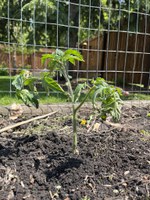Dakota Gardener: Fresh garden tomatoes
(Click an image below to view a high-resolution image that can be downloaded)
By Carrie Knutson, Horticulture agent
NDSU Extension – Grand Forks County
I think there is nothing better than a fresh tomato from the garden. This is one statement that I find most gardeners will not argue about. Generally, gardeners will go above and beyond to ensure they can harvest a plentiful tomato crop. So, how do we get the most out of our tomatoes?
You can use cages or a fence and a string trellis system to support the tomato plant and hold the vines off the ground. I use tomato cages, which I set up after I plant. However, tomato cages can have a bad reputation. They tend to fall over during storms or as tomatoes ripen later in the summer.
One trick to stop that from happening is to use two short fencing posts to support the cages. Simply place the tomato cage, then put the posts in the ground at an equal distance around the cage and zip-tie the cage to the posts. It takes a bit more work to set up, but the results are worth it—no more tipped-over tomatoes.
Remember to prune your tomatoes. Tomatoes will grow secondary stems or shoots between leaves and the main stem. Depending on your needs and the type of tomato you are growing, you can prune one or the secondary stems out or leave them all.
If you leave the secondary stems, you will have more vines for fruit production. Just make sure your support system can handle the additional weight. I tend to remove the first secondary stems on my determinate tomatoes and let the rest grow. Secondary stems can be removed when they are about the size of a pencil and the leaves are dry. A sharp pair of scissors or pruners should be used to remove them to avoid damaging the main stem.
As your tomatoes grow, you can remove a couple of the bottom leaves to promote air movement and help prevent the spread of disease. Mulch will also help reduce the spread of soil-borne diseases. Examples of mulch are clean straw, compost, grass clippings or leaves. Just make sure that anything you use is free of any herbicides.
Be sure to leave space around the stems of your plants when using mulch. You don’t want to put mulch up to the base of the plant, as this could cause mold issues in the stem.
The mulch also helps suppress weeds and keeps the moisture at a constant level. Blossom end rot can be a major issue on tomatoes early in the season. It is caused by a calcium deficiency in the plant. Often, we have enough calcium in the soil, but due to fluctuations in soil moisture, it cannot be taken up by the plant.
Try not to work with tomato plants when they are wet. This will help reduce the spread of certain diseases. When watering, water the roots and soil, not the leaves. If you use an overhead sprinkler, water early in the morning. Watering in the morning reduces the chances of disease development.
Last, make sure to look at your plants at least every few days. Check in with them and look for any potential problems so that you have time to troubleshoot before you lose tomatoes.
Happy gardening!
NDSU Agriculture Communication – June 11, 2025
Source: Carrie Knutson, 701-780-8229, carrie.knutson@ndsu.edu
Editor: Kelli Anderson, 701-231-6136, kelli.c.anderson@ndsu.edu




